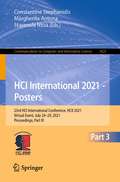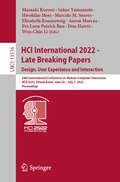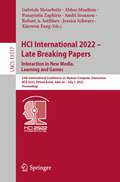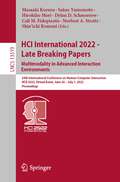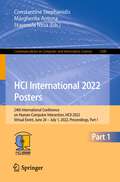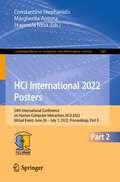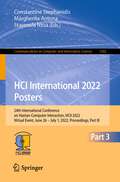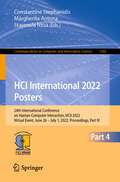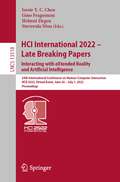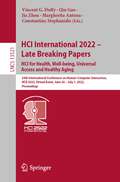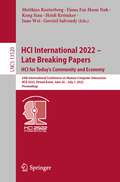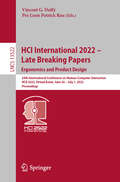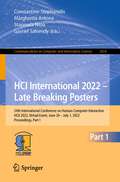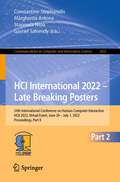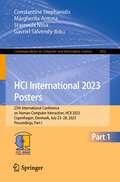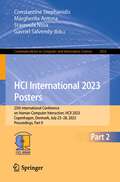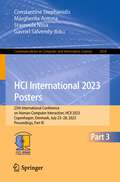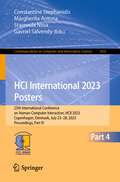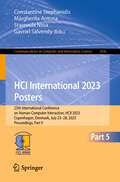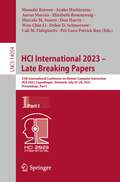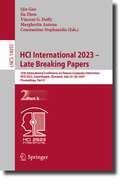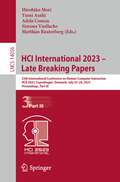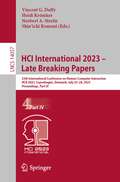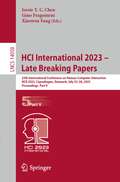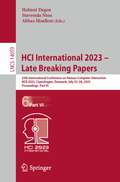- Table View
- List View
HCI International 2021 - Posters: 23rd HCI International Conference, HCII 2021, Virtual Event, July 24–29, 2021, Proceedings, Part III (Communications in Computer and Information Science #1421)
by Margherita Antona Constantine Stephanidis Stavroula NtoaThe three-volume set CCIS 1419, CCIS 1420, and CCIS 1421 contains the extended abstracts of the posters presented during the 23rd International Conference on Human-Computer Interaction, HCII 2021, which was held virtually in July 2021. HCII 2021 received a total of 6326 submissions, of which 1439 papers and 238 posters were accepted for publication in the pre-conference proceedings after a careful reviewing process.The 238 poster papers presented in these three volumes are organized in topical sections as follows: Part I: HCI theory and methods; perceptual, cognitive and psychophisiological aspects of interaction; designing for children; designing for older people; design case studies; dimensions of user experience; information, language, culture and media. Part II: interaction methods and techniques; eye-tracking and facial expressions recognition; human-robot interaction; virtual, augmented and mixed reality; sand privacy issues in HCI; AI and machine learning in HCI. Part III: interacting and learning; interacting and playing; interacting and driving; digital wellbeing, eHealth and mHealth; interacting and shopping; HCI, safety and sustainability; HCI in the time of pandemic.
HCI International 2022 - Late Breaking Papers. Design, User Experience and Interaction: 24th International Conference on Human-Computer Interaction, HCII 2022, Virtual Event, June 26 – July 1, 2022, Proceedings (Lecture Notes in Computer Science #13516)
by Aaron Marcus Masaaki Kurosu Don Harris Sakae Yamamoto Pei-Luen Patrick Rau Hirohiko Mori Marcelo M. Soares Elizabeth Rosenzweig Wen-Chin LiVolume LNCS 13516 is part of the refereed proceedings of the 24th International Conference on Human-Computer Interaction, HCII 2022, which was held virtually during June 26 to July 1, 2022.A total of 5583 individuals from academia, research institutes, industry, and governmental agencies from 88 countries submitted contributions, and 1276 papers and 275 posters were included in the proceedings that were published just before the start of the conference. Additionally, 296 papers and 181 posters are included in the volumes of the proceedings published after the conference, as “Late Breaking Work” (papers and posters). The contributions thoroughly cover the entire field of human-computer interaction, addressing major advances in knowledge and effective use of computers in a variety of application areas.
HCI International 2022 - Late Breaking Papers. Interaction in New Media, Learning and Games: 24th International Conference on Human-Computer Interaction, HCII 2022, Virtual Event, June 26–July 1, 2022, Proceedings (Lecture Notes in Computer Science #13517)
by Gabriele Meiselwitz Panayiotis Zaphiris Andri Ioannou Jessica Schwarz Abbas Moallem Robert A. Sottilare Xiaowen FangThis proceedings LNCS 13517 constitutes the refereed proceedings of the 24th International Conference on Human-Computer Interaction, HCII 2022, which was held virtually as part of the 24th International Conference, HCII 2022, in June/July 2022. HCII 2022 received a total of 5583 submissions from academia, research institutes, industry, and governmental agencies from 88 countries submitted contributions, and 1276 papers and 275 posters were included in the proceedings that were published just before the start of the conference. Additionally, 296 papers and 181 posters are included in the volumes of the proceedings published after the conference, as “Late Breaking Work” (papers and posters). The contributions thoroughly cover the entire field of human-computer interaction, addressing major advances in knowledge and effective use of computers in a variety of application areas.
HCI International 2022 - Late Breaking Papers. Multimodality in Advanced Interaction Environments: 24th International Conference on Human-Computer Interaction, HCII 2022, Virtual Event, June 26 – July 1, 2022, Proceedings (Lecture Notes in Computer Science #13519)
by Dylan D. Schmorrow Cali M. Fidopiastis Masaaki Kurosu Sakae Yamamoto Shin’ichi Konomi Hirohiko Mori Norbert A. StreitzVolume LNCS 13519 is part of the refereed proceedings of the 24th International Conference on Human-Computer Interaction, HCII 2022, which was held virtually during June 26 to July 1, 2022.A total of 5583 individuals from academia, research institutes, industry, and governmental agencies from 88 countries submitted contributions, and 1276 papers and 275 posters were included in the proceedings that were published just before the start of the conference. Additionally, 296 papers and 181 posters are included in the volumes of the proceedings published after the conference, as “Late Breaking Work” (papers and posters). The contributions thoroughly cover the entire field of human-computer interaction, addressing major advances in knowledge and effective use of computers in a variety of application areas.
HCI International 2022 Posters: 24th International Conference on Human-Computer Interaction, HCII 2022, Virtual Event, June 26 – July 1, 2022, Proceedings, Part I (Communications in Computer and Information Science #1580)
by Margherita Antona Constantine Stephanidis Stavroula NtoaThe four-volume set CCIS 1580, CCIS 1581, CCIS 1582, and CCIS 1583 contains the extended abstracts of the posters presented during the 24th International Conference on Human-Computer Interaction, HCII 2022, which was held virtually in June - July 2022. The total of 1276 papers and 275 posters included in the 40 HCII 2021 proceedings volumes was carefully reviewed and selected from 5583 submissions.The posters presented in these four volumes are organized in topical sections as follows: Part I: user experience design and evaluation; visual design and visualization; data, information and knowledge; interacting with AI; universal access, accessibility and design for aging. Part II: multimodal and natural interaction; perception, cognition, emotion and psychophysiological monitoring; human motion modelling and monitoring; IoT and intelligent living environments. Part III: learning technologies; HCI, cultural heritage and art; eGovernment and eBusiness; digital commerce and the customer experience; social media and the metaverse. Part IV: virtual and augmented reality; autonomous vehicles and urban mobility; product and robot design; HCI and wellbeing; HCI and cybersecurity.
HCI International 2022 Posters: 24th International Conference on Human-Computer Interaction, HCII 2022, Virtual Event, June 26 – July 1, 2022, Proceedings, Part II (Communications in Computer and Information Science #1581)
by Margherita Antona Constantine Stephanidis Stavroula NtoaThe four-volume set CCIS 1580, CCIS 1581, CCIS 1582, and CCIS 1583 contains the extended abstracts of the posters presented during the 24th International Conference on Human-Computer Interaction, HCII 2022, which was held virtually in June - July 2022. The total of 1276 papers and 275 posters included in the 40 HCII 2021 proceedings volumes was carefully reviewed and selected from 5583 submissions.The posters presented in these four volumes are organized in topical sections as follows: Part I: user experience design and evaluation; visual design and visualization; data, information and knowledge; interacting with AI; universal access, accessibility and design for aging. Part II: multimodal and natural interaction; perception, cognition, emotion and psychophysiological monitoring; human motion modelling and monitoring; IoT and intelligent living environments. Part III: learning technologies; HCI, cultural heritage and art; eGovernment and eBusiness; digital commerce and the customer experience; social media and the metaverse. Part IV: virtual and augmented reality; autonomous vehicles and urban mobility; product and robot design; HCI and wellbeing; HCI and cybersecurity.
HCI International 2022 Posters: 24th International Conference on Human-Computer Interaction, HCII 2022, Virtual Event, June 26 – July 1, 2022, Proceedings, Part III (Communications in Computer and Information Science #1582)
by Margherita Antona Constantine Stephanidis Stavroula NtoaThe four-volume set CCIS 1580, CCIS 1581, CCIS 1582, and CCIS 1583 contains the extended abstracts of the posters presented during the 24th International Conference on Human-Computer Interaction, HCII 2022, which was held virtually in June - July 2022. The total of 1276 papers and 275 posters included in the 40 HCII 2021 proceedings volumes was carefully reviewed and selected from 5583 submissions.The posters presented in these four volumes are organized in topical sections as follows: Part I: user experience design and evaluation; visual design and visualization; data, information and knowledge; interacting with AI; universal access, accessibility and design for aging. Part II: multimodal and natural interaction; perception, cognition, emotion and psychophysiological monitoring; human motion modelling and monitoring; IoT and intelligent living environments. Part III: learning technologies; HCI, cultural heritage and art; eGovernment and eBusiness; digital commerce and the customer experience; social media and the metaverse. Part IV: virtual and augmented reality; autonomous vehicles and urban mobility; product and robot design; HCI and wellbeing; HCI and cybersecurity.
HCI International 2022 Posters: 24th International Conference on Human-Computer Interaction, HCII 2022, Virtual Event, June 26 – July 1, 2022, Proceedings, Part IV (Communications in Computer and Information Science #1583)
by Margherita Antona Constantine Stephanidis Stavroula NtoaThe four-volume set CCIS 1580, CCIS 1581, CCIS 1582, and CCIS 1583 contains the extended abstracts of the posters presented during the 24th International Conference on Human-Computer Interaction, HCII 2022, which was held virtually in June - July 2022. The total of 1276 papers and 275 posters included in the 40 HCII 2021 proceedings volumes was carefully reviewed and selected from 5583 submissions.The posters presented in these four volumes are organized in topical sections as follows: Part I: user experience design and evaluation; visual design and visualization; data, information and knowledge; interacting with AI; universal access, accessibility and design for aging. Part II: multimodal and natural interaction; perception, cognition, emotion and psychophysiological monitoring; human motion modelling and monitoring; IoT and intelligent living environments. Part III: learning technologies; HCI, cultural heritage and art; eGovernment and eBusiness; digital commerce and the customer experience; social media and the metaverse. Part IV: virtual and augmented reality; autonomous vehicles and urban mobility; product and robot design; HCI and wellbeing; HCI and cybersecurity.
HCI International 2022 – Late Breaking Papers: 24th International Conference on Human-Computer Interaction, HCII 2022, Virtual Event, June 26 – July 1, 2022, Proceedings (Lecture Notes in Computer Science #13518)
by Gino Fragomeni Jessie Y. C. Chen Helmut Degen Stavroula NtoaThis proceedings LNCS 13518 constitutes the refereed proceedings of the 24th International Conference on Human-Computer Interaction, HCII 2022, which was held virtually as part of the 24th International Conference, HCII 2022, in June/July 2022. HCII 2022 received a total of 5583 submissions from academia, research institutes, industry, and governmental agencies from 88 countries submitted contributions, and 1276 papers and 275 posters were included in the proceedings that were published just before the start of the conference. Additionally, 296 papers and 181 posters are included in the volumes of the proceedings published after the conference, as “Late Breaking Work” (papers and posters). The contributions thoroughly cover the entire field of human-computer interaction, addressing major advances in knowledge and effective use of computers in a variety of application areas.
HCI International 2022 – Late Breaking Papers: 24th International Conference on Human-Computer Interaction, HCII 2022, Virtual Event, June 26 – July 1, 2022, Proceedings (Lecture Notes in Computer Science #13521)
by Jia Zhou Margherita Antona Constantine Stephanidis Vincent G. Duffy Qin GaoThis proceedings LNCS 13521 constitutes the refereed proceedings of the 24th International Conference on Human-Computer Interaction, HCII 2022, which was held virtually as part of the 24th International Conference, HCII 2022, in June 26 to July 1, 2022. HCII 2022 received a total of 5583 submissions from academia, research institutes, industry, and governmental agencies from 88 countries submitted contributions, and 1276 papers and 275 posters were included in the proceedings that were published just before the start of the conference. Additionally, 296 papers and 181 posters are included in the volumes of the proceedings published after the conference, as “Late Breaking Work” (papers and posters). The contributions thoroughly cover the entire field of human-computer interaction, addressing major advances in knowledge and effective use of computers in a variety of application areas.
HCI International 2022 – Late Breaking Papers: 24th International Conference on Human-Computer Interaction, HCII 2022, Virtual Event, June 26–July 1, 2022, Proceedings (Lecture Notes in Computer Science #13520)
by Gavriel Salvendy Fiona Fui-Hoon Nah Matthias Rauterberg June Wei Heidi Krömker Keng SiauThis proceedings LNCS 13516 constitutes the refereed proceedings of the 24th International Conference on Human-Computer Interaction, HCII 2022, which was held virtually as part of the 24th International Conference, HCII 2022, during June 26 to July 1, 2022. HCII 2022 received a total of 5583 submissions from academia, research institutes, industry, and governmental agencies from 88 countries submitted contributions, and 1276 papers and 275 posters were included in the proceedings that were published just before the start of the conference. Additionally, 296 papers and 181 posters are included in the volumes of the proceedings published after the conference, as “Late Breaking Work” (papers and posters). The contributions thoroughly cover the entire field of human-computer interaction, addressing major advances in knowledge and effective use of computers in a variety of application areas.
HCI International 2022 – Late Breaking Papers: 24th International Conference on Human-Computer Interaction, HCII 2022, Virtual Event, June 26–July 1, 2022, Proceedings (Lecture Notes in Computer Science #13522)
by Vincent G. Duffy Pei-Luen Patrick RauVolume LNCS 13522 is part of the refereed proceedings of the 24th International Conference on Human-Computer Interaction, HCII 2022, which was held virtually during June 26 to July 1, 2022.A total of 5583 individuals from academia, research institutes, industry, and governmental agencies from 88 countries submitted contributions, and 1276 papers and 275 posters were included in the proceedings that were published just before the start of the conference. Additionally, 296 papers and 181 posters are included in the volumes of the proceedings published after the conference, as “Late Breaking Work” (papers and posters). The contributions thoroughly cover the entire field of human-computer interaction, addressing major advances in knowledge and effective use of computers in a variety of application areas.
HCI International 2022 – Late Breaking Posters: 24th International Conference on Human-Computer Interaction, HCII 2022, Virtual Event, June 26 – July 1, 2022, Proceedings, Part I (Communications in Computer and Information Science #1654)
by Gavriel Salvendy Margherita Antona Constantine Stephanidis Stavroula NtoaVolume CCIS 1654 is part of the refereed proceedings of the 24th International Conference on Human-Computer Interaction, HCII 2022, which was held virtually during June 26 to July 1, 2022. A total of 5583 individuals from academia, research institutes, industry, and governmental agencies from 88 countries submitted contributions, and 1276 papers and 275 posters were included in the proceedings that were published just before the start of the conference. Additionally, 296 papers and 181 posters are included in the volumes of the proceedings published after the conference, as “Late Breaking Work” (papers and posters). The contributions thoroughly cover the entire field of human-computer interaction, addressing major advances in knowledge and effective use of computers in a variety of application areas.
HCI International 2022 – Late Breaking Posters: 24th International Conference on Human-Computer Interaction, HCII 2022, Virtual Event, June 26 – July 1, 2022, Proceedings, Part II (Communications in Computer and Information Science #1655)
by Gavriel Salvendy Margherita Antona Constantine Stephanidis Stavroula NtoaVolume CCIS 1655 is part of the refereed proceedings of the 24th International Conference on Human-Computer Interaction, HCII 2022, which was held virtually during June 26 to July 1, 2022. A total of 5583 individuals from academia, research institutes, industry, and governmental agencies from 88 countries submitted contributions, and 1276 papers and 275 posters were included in the proceedings that were published just before the start of the conference. Additionally, 296 papers and 181 posters are included in the volumes of the proceedings published after the conference, as “Late Breaking Work” (papers and posters). The contributions thoroughly cover the entire field of human-computer interaction, addressing major advances in knowledge and effective use of computers in a variety of application areas.
HCI International 2023 Posters: 25th International Conference on Human-Computer Interaction, HCII 2023, Copenhagen, Denmark, July 23–28, 2023, Proceedings, Part I (Communications in Computer and Information Science #1832)
by Gavriel Salvendy Margherita Antona Constantine Stephanidis Stavroula NtoaThe five-volume set CCIS 1832-1836 contains the extended abstracts of the posters presented during the 25th International Conference on Human-Computer Interaction, HCII 2023, which was held as a hybrid event in Copenhagen, Denmark, in July 2023.The total of 1578 papers and 396 posters included in the 47 HCII 2023 proceedings volumes were carefully reviewed and selected from the 7472 contributions.The posters presented in these five volumes are organized in topical sections as follows: Part I: HCI Design: Theoretical Approaches, Methods and Case Studies; Multimodality and Novel Interaction Techniques and Devices; Perception and Cognition in Interaction; Ethics, Transparency and Trust in HCI; User Experience and Technology Acceptance Studies.Part II: Supporting Health, Psychological Wellbeing, and Fitness; Design for All, Accessibility and Rehabilitation Technologies; Interactive Technologies for the Aging Population.Part III: Interacting with Data, Information and Knowledge; Learning and Training Technologies; Interacting with Cultural Heritage and Art.Part IV: Social Media: Design, User Experiences and Content Analysis; Advances in eGovernment Services; eCommerce, Mobile Commerce and Digital Marketing: Design and Customer Behavior; Designing and Developing Intelligent Green Environments; (Smart) Product Design.Part V: Driving Support and Experiences in Automated Vehicles; eXtended Reality: Design, Interaction Techniques, User Experience and Novel Applications; Applications of AI Technologies in HCI.
HCI International 2023 Posters: 25th International Conference on Human-Computer Interaction, HCII 2023, Copenhagen, Denmark, July 23–28, 2023, Proceedings, Part II (Communications in Computer and Information Science #1833)
by Gavriel Salvendy Margherita Antona Constantine Stephanidis Stavroula NtoaThe five-volume set CCIS 1832-1836 contains the extended abstracts of the posters presented during the 25th International Conference on Human-Computer Interaction, HCII 2023, which was held as a hybrid event in Copenhagen, Denmark, in July 2023.The total of 1578 papers and 396 posters included in the 47 HCII 2023 proceedings volumes were carefully reviewed and selected from the 7472 contributions.The posters presented in these five volumes are organized in topical sections as follows: Part I: HCI Design: Theoretical Approaches, Methods and Case Studies; Multimodality and Novel Interaction Techniques and Devices; Perception and Cognition in Interaction; Ethics, Transparency and Trust in HCI; User Experience and Technology Acceptance Studies.Part II: Supporting Health, Psychological Wellbeing, and Fitness; Design for All, Accessibility and Rehabilitation Technologies; Interactive Technologies for the Aging Population.Part III: Interacting with Data, Information and Knowledge; Learning and Training Technologies; Interacting with Cultural Heritage and Art.Part IV: Social Media: Design, User Experiences and Content Analysis; Advances in eGovernment Services; eCommerce, Mobile Commerce and Digital Marketing: Design and Customer Behavior; Designing and Developing Intelligent Green Environments; (Smart) Product Design.Part V: Driving Support and Experiences in Automated Vehicles; eXtended Reality: Design, Interaction Techniques, User Experience and Novel Applications; Applications of AI Technologies in HCI.
HCI International 2023 Posters: 25th International Conference on Human-Computer Interaction, HCII 2023, Copenhagen, Denmark, July 23–28, 2023, Proceedings, Part III (Communications in Computer and Information Science #1834)
by Gavriel Salvendy Margherita Antona Constantine Stephanidis Stavroula NtoaThe five-volume set CCIS 1832-1836 contains the extended abstracts of the posters presented during the 25th International Conference on Human-Computer Interaction, HCII 2023, which was held as a hybrid event in Copenhagen, Denmark, in July 2023.The total of 1578 papers and 396 posters included in the 47 HCII 2023 proceedings volumes were carefully reviewed and selected from the 7472 contributions.The posters presented in these five volumes are organized in topical sections as follows: Part I: HCI Design: Theoretical Approaches, Methods and Case Studies; Multimodality and Novel Interaction Techniques and Devices; Perception and Cognition in Interaction; Ethics, Transparency and Trust in HCI; User Experience and Technology Acceptance Studies.Part II: Supporting Health, Psychological Wellbeing, and Fitness; Design for All, Accessibility and Rehabilitation Technologies; Interactive Technologies for the Aging Population.Part III: Interacting with Data, Information and Knowledge; Learning and Training Technologies; Interacting with Cultural Heritage and Art.Part IV: Social Media: Design, User Experiences and Content Analysis; Advances in eGovernment Services; eCommerce, Mobile Commerce and Digital Marketing: Design and Customer Behavior; Designing and Developing Intelligent Green Environments; (Smart) Product Design.Part V: Driving Support and Experiences in Automated Vehicles; eXtended Reality: Design, Interaction Techniques, User Experience and Novel Applications; Applications of AI Technologies in HCI.
HCI International 2023 Posters: 25th International Conference on Human-Computer Interaction, HCII 2023, Copenhagen, Denmark, July 23–28, 2023, Proceedings, Part IV (Communications in Computer and Information Science #1835)
by Gavriel Salvendy Margherita Antona Constantine Stephanidis Stavroula NtoaThe five-volume set CCIS 1832-1836 contains the extended abstracts of the posters presented during the 25th International Conference on Human-Computer Interaction, HCII 2023, which was held as a hybrid event in Copenhagen, Denmark, in July 2023.The total of 1578 papers and 396 posters included in the 47 HCII 2023 proceedings volumes were carefully reviewed and selected from the 7472 contributions.The posters presented in these five volumes are organized in topical sections as follows: Part I: HCI Design: Theoretical Approaches, Methods and Case Studies; Multimodality and Novel Interaction Techniques and Devices; Perception and Cognition in Interaction; Ethics, Transparency and Trust in HCI; User Experience and Technology Acceptance Studies.Part II: Supporting Health, Psychological Wellbeing, and Fitness; Design for All, Accessibility and Rehabilitation Technologies; Interactive Technologies for the Aging Population.Part III: Interacting with Data, Information and Knowledge; Learning and Training Technologies; Interacting with Cultural Heritage and Art.Part IV: Social Media: Design, User Experiences and Content Analysis; Advances in eGovernment Services; eCommerce, Mobile Commerce and Digital Marketing: Design and Customer Behavior; Designing and Developing Intelligent Green Environments; (Smart) Product Design.Part V: Driving Support and Experiences in Automated Vehicles; eXtended Reality: Design, Interaction Techniques, User Experience and Novel Applications; Applications of AI Technologies in HCI.
HCI International 2023 Posters: 25th International Conference on Human-Computer Interaction, HCII 2023, Copenhagen, Denmark, July 23–28, 2023, Proceedings, Part V (Communications in Computer and Information Science #1836)
by Gavriel Salvendy Margherita Antona Constantine Stephanidis Stavroula NtoaThe five-volume set CCIS 1832-1836 contains the extended abstracts of the posters presented during the 25th International Conference on Human-Computer Interaction, HCII 2023, which was held as a hybrid event in Copenhagen, Denmark, in July 2023.The total of 1578 papers and 396 posters included in the 47 HCII 2023 proceedings volumes were carefully reviewed and selected from the 7472 contributions.The posters presented in these five volumes are organized in topical sections as follows: Part I: HCI Design: Theoretical Approaches, Methods and Case Studies; Multimodality and Novel Interaction Techniques and Devices; Perception and Cognition in Interaction; Ethics, Transparency and Trust in HCI; User Experience and Technology Acceptance Studies.Part II: Supporting Health, Psychological Wellbeing, and Fitness; Design for All, Accessibility and Rehabilitation Technologies; Interactive Technologies for the Aging Population.Part III: Interacting with Data, Information and Knowledge; Learning and Training Technologies; Interacting with Cultural Heritage and Art.Part IV: Social Media: Design, User Experiences and Content Analysis; Advances in eGovernment Services; eCommerce, Mobile Commerce and Digital Marketing: Design and Customer Behavior; Designing and Developing Intelligent Green Environments; (Smart) Product Design.Part V: Driving Support and Experiences in Automated Vehicles; eXtended Reality: Design, Interaction Techniques, User Experience and Novel Applications; Applications of AI Technologies in HCI.
HCI International 2023 – Late Breaking Papers: 25th International Conference on Human-Computer Interaction, HCII 2023, Copenhagen, Denmark, July 23–28, 2023, Proceedings, Part I (Lecture Notes in Computer Science #14054)
by Aaron Marcus Dylan D. Schmorrow Cali M. Fidopiastis Masaaki Kurosu Don Harris Pei-Luen Patrick Rau Ayako Hashizume Marcelo M. Soares Elizabeth Rosenzweig Wen-Chin LiThis seven-volume set LNCS 14054-14060 constitutes the proceedings of the 25th International Conference, HCI International 2023, in Copenhagen, Denmark, in July 2023. For the HCCII 2023 proceedings, a total of 1578 papers and 396 posters was carefully reviewed and selected from 7472 submissions. Additionally, 267 papers and 133 posters are included in the volumes of the proceedings published after the conference, as “Late Breaking Work”. These papers were organized in the following topical sections: HCI Design and User Experience; Cognitive Engineering and Augmented Cognition; Cultural Issues in Design; Technologies for the Aging Population; Accessibility and Design for All; Designing for Health and Wellbeing; Information Design, Visualization, Decision-making and Collaboration; Social Media, Creative Industries and Cultural Digital Experiences; Digital Human Modeling, Ergonomics and Safety; HCI in Automated Vehicles and Intelligent Transportation; Sustainable Green Smart Cities and Smart Industry; eXtended Reality Interactions; Gaming and Gamification Experiences; Interacting with Artificial Intelligence; Security, Privacy, Trust and Ethics; Learning Technologies and Learning Experiences; eCommerce, Digital Marketing and eFinance.
HCI International 2023 – Late Breaking Papers: 25th International Conference on Human-Computer Interaction, HCII 2023, Copenhagen, Denmark, July 23–28, 2023, Proceedings, Part II (Lecture Notes in Computer Science #14055)
by Jia Zhou Margherita Antona Constantine Stephanidis Vincent G. Duffy Qin GaoThis seven-volume set LNCS 14054-14060 constitutes the proceedings of the 25th International Conference, HCI International 2023, in Copenhagen, Denmark, in July 2023. For the HCCII 2023 proceedings, a total of 1578 papers and 396 posters was carefully reviewed and selected from 7472 submissions. Additionally, 267 papers and 133 posters are included in the volumes of the proceedings published after the conference, as “Late Breaking Work”. These papers were organized in the following topical sections: HCI Design and User Experience; Cognitive Engineering and Augmented Cognition; Cultural Issues in Design; Technologies for the Aging Population; Accessibility and Design for All; Designing for Health and Wellbeing; Information Design, Visualization, Decision-making and Collaboration; Social Media, Creative Industries and Cultural Digital Experiences; Digital Human Modeling, Ergonomics and Safety; HCI in Automated Vehicles and Intelligent Transportation; Sustainable Green Smart Cities and Smart Industry; eXtended Reality Interactions; Gaming and Gamification Experiences; Interacting with Artificial Intelligence; Security, Privacy, Trust and Ethics; Learning Technologies and Learning Experiences; eCommerce, Digital Marketing and eFinance.
HCI International 2023 – Late Breaking Papers: 25th International Conference on Human-Computer Interaction, HCII 2023, Copenhagen, Denmark, July 23–28, 2023, Proceedings, Part III (Lecture Notes in Computer Science #14056)
by Matthias Rauterberg Hirohiko Mori Yumi Asahi Adela Coman Simona VasilacheThis seven-volume set LNCS 14054-14060 constitutes the proceedings of the 25th International Conference, HCI International 2023, in Copenhagen, Denmark, in July 2023. For the HCCII 2023 proceedings, a total of 1578 papers and 396 posters was carefully reviewed and selected from 7472 submissions. Additionally, 267 papers and 133 posters are included in the volumes of the proceedings published after the conference, as “Late Breaking Work”. These papers were organized in the following topical sections: HCI Design and User Experience; Cognitive Engineering and Augmented Cognition; Cultural Issues in Design; Technologies for the Aging Population; Accessibility and Design for All; Designing for Health and Wellbeing; Information Design, Visualization, Decision-making and Collaboration; Social Media, Creative Industries and Cultural Digital Experiences; Digital Human Modeling, Ergonomics and Safety; HCI in Automated Vehicles and Intelligent Transportation; Sustainable Green Smart Cities and Smart Industry; eXtended Reality Interactions; Gaming and Gamification Experiences; Interacting with Artificial Intelligence; Security, Privacy, Trust and Ethics; Learning Technologies and Learning Experiences; eCommerce, Digital Marketing and eFinance.
HCI International 2023 – Late Breaking Papers: 25th International Conference on Human-Computer Interaction, HCII 2023, Copenhagen, Denmark, July 23–28, 2023, Proceedings, Part IV (Lecture Notes in Computer Science #14057)
by Vincent G. Duffy Heidi Krömker Norbert A. Streitz Shin'Ichi KonomiThis seven-volume set LNCS 14054-14060 constitutes the proceedings of the 25th International Conference, HCI International 2023, in Copenhagen, Denmark, in July 2023. For the HCCII 2023 proceedings, a total of 1578 papers and 396 posters was carefully reviewed and selected from 7472 submissions. Additionally, 267 papers and 133 posters are included in the volumes of the proceedings published after the conference, as “Late Breaking Work”. These papers were organized in the following topical sections: HCI Design and User Experience; Cognitive Engineering and Augmented Cognition; Cultural Issues in Design; Technologies for the Aging Population; Accessibility and Design for All; Designing for Health and Wellbeing; Information Design, Visualization, Decision-making and Collaboration; Social Media, Creative Industries and Cultural Digital Experiences; Digital Human Modeling, Ergonomics and Safety; HCI in Automated Vehicles and Intelligent Transportation; Sustainable Green Smart Cities and Smart Industry; eXtended Reality Interactions; Gaming and Gamification Experiences; Interacting with Artificial Intelligence; Security, Privacy, Trust and Ethics; Learning Technologies and Learning Experiences; eCommerce, Digital Marketing and eFinance.
HCI International 2023 – Late Breaking Papers: 25th International Conference on Human-Computer Interaction, HCII 2023, Copenhagen, Denmark, July 23–28, 2023, Proceedings, Part V (Lecture Notes in Computer Science #14058)
by Gino Fragomeni Jessie Y. C. Chen Xiaowen FangThis seven-volume set LNCS 14054-14060 constitutes the proceedings of the 25th International Conference, HCI International 2023, in Copenhagen, Denmark, in July 2023. For the HCCII 2023 proceedings, a total of 1578 papers and 396 posters was carefully reviewed and selected from 7472 submissions. Additionally, 267 papers and 133 posters are included in the volumes of the proceedings published after the conference, as “Late Breaking Work”. These papers were organized in the following topical sections: HCI Design and User Experience; Cognitive Engineering and Augmented Cognition; Cultural Issues in Design; Technologies for the Aging Population; Accessibility and Design for All; Designing for Health and Wellbeing; Information Design, Visualization, Decision-making and Collaboration; Social Media, Creative Industries and Cultural Digital Experiences; Digital Human Modeling, Ergonomics and Safety; HCI in Automated Vehicles and Intelligent Transportation; Sustainable Green Smart Cities and Smart Industry; eXtended Reality Interactions; Gaming and Gamification Experiences; Interacting with Artificial Intelligence; Security, Privacy, Trust and Ethics; Learning Technologies and Learning Experiences; eCommerce, Digital Marketing and eFinance.
HCI International 2023 – Late Breaking Papers: 25th International Conference on Human-Computer Interaction, HCII 2023, Copenhagen, Denmark, July 23–28, 2023, Proceedings, Part VI (Lecture Notes in Computer Science #14059)
by Abbas Moallem Helmut Degen Stavroula NtoaThis seven-volume set LNCS 14054-14060 constitutes the proceedings of the 25th International Conference, HCI International 2023, in Copenhagen, Denmark, in July 2023. For the HCCII 2023 proceedings, a total of 1578 papers and 396 posters was carefully reviewed and selected from 7472 submissions. Additionally, 267 papers and 133 posters are included in the volumes of the proceedings published after the conference, as “Late Breaking Work”. These papers were organized in the following topical sections: HCI Design and User Experience; Cognitive Engineering and Augmented Cognition; Cultural Issues in Design; Technologies for the Aging Population; Accessibility and Design for All; Designing for Health and Wellbeing; Information Design, Visualization, Decision-making and Collaboration; Social Media, Creative Industries and Cultural Digital Experiences; Digital Human Modeling, Ergonomics and Safety; HCI in Automated Vehicles and Intelligent Transportation; Sustainable Green Smart Cities and Smart Industry; eXtended Reality Interactions; Gaming and Gamification Experiences; Interacting with Artificial Intelligence; Security, Privacy, Trust and Ethics; Learning Technologies and Learning Experiences; eCommerce, Digital Marketing and eFinance.
